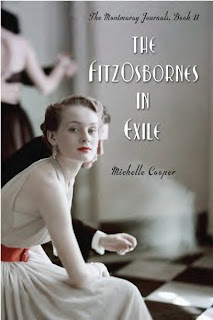The FitzOsbornes In Exile by Michelle Cooper
My 2 cents:
Michelle Cooper
doesn't miss a beat. Not one. The FitzOsbornes in Exile begins where
the prequel, A Brief History of Montmaray, leaves off – with
Princess Sophia at Aunt Charlotte's sumptuous England estate.
“I write this
sitting at an exquisite little Louis the Fifteenth secretaire in the
White Drawing Room, using a gold fountain pen borrowed from the King
of Montmaray (Toby), and a bottle of ink provided by one of the
footmen. Fortunately, the paper is just a six-penny exercise book
that I bought in the village this morning – otherwise I'd be too
intimidated to write a word. Anyway, here I sit, scribbling away in
my journal on this first full day of my new life.” (p. 3)
Sophia's new life in London is quite the contrast
from her life at Montmaray. Remember the smoking stove, Vulcan, and
Sophia huddled under dusty covers under a leaky roof to write her
journal entries. In this second novel of the Montmaray
series, Cooper's writing is stellar. It's concise, sparkling and
really funny. Mostly, because the characters are sparkling and funny.
“Exile” is set in the months leading up to WWII, from January
1937 to August 1939. Princess Sophia tells the story of her family:
her younger sister, Henry (Henrietta), older brother, Toby, and
cousin, Veronica. The four have been orphaned by a car bombing in
Spain (Sophia's mother and father), and a fatal stroke (Veronica's
father, King John), provoked by an unfriendly encounter with two
German soldiers. The ensuing air assault destroyed the Montmaray
castle and forced the four to flee in exile to London, along with
Simon Chester and his mother, Rebecca. Meanwhile, the island is most
likely being used as a landing base for German airplanes. Aunt
Charlotte, who is very rich, very stern and now widowed, focuses her
free time on raising horses, trying to find suitable marriage
partners for Sophia, Veronica and Toby, and educating wild, young
Henry. Not counting her prize horses, it's an uphill battle for Aunt
Charlotte, given the fact that Toby fancies Simon, Aunt Charlotte's
male secretary, and Veronica is consumed with the dangerous task of
exposing Germany's aggression toward Montmaray. Henry goes through
governesses like water through a colander, and Sophia … well,
Sophia is the keeper of the journals. She becomes friends with a boy
(and animal lover) named Rupert, but she also has a bit of a crush on
Simon, as well. Also, Sophia is learning to find words to voice her
growing opinions on, well, just about everything going on around her.
Which is a lot.
“I
do make a habit of observing people,” I said. “Not just you. It's
simply that there weren't many other people to observe at Montmaray.”
(p. 35-6, an excerpt from Sophia in a pivotal conversation with
Simon).
Henry's assessment of her first riding lesson is hilarious, (p. 61):
“Well!
You won't believe
it!” exclaimed Henry. “I had to put both my legs on one side, in
this silly girls' saddle! I thought it would be like pictures of
cowboys, a leg on either side of the horse. How else is one supposed
to stay on? But Aunt Charlotte says that only boys get to ride like
that! It's the stupidest thing! It ought to be the other way round.
It's boys who have dangling bits between their legs – they
ought to be the ones riding sidesaddle!”
The novel weaves true bits of
historical facts into Sophia's journal, like Hitler's progressive
take-over of European countries, his propaganda
campaign and cruelty toward Jews. Oddly, even with the dark cloud of
WWII stories as a backdrop, I laughed out loud throughout the book,
especially at Veronica and Toby's intense discussions. Cooper has a
brilliant flair for dialogue.
In closing, let me just say this, if
The FitzOsbornes in Exile is ever made into a movie, I nominate
Taylor Swift to play the part of Sophie. Taylor fits the part, down
to the light blonde hair, fair skin and penchant for spilling her
guts onto paper. And, just imagine the songs Taylor could write about
all the relationships in this novel … and the scenery and costumes
from late-30's London. Just … wow!
LENGTH: 450 pages
WORTH YOUR TIME: Yes! For the history,
the dialogue and the characters – yes, yes, yes!
Helpful Hint: Recommended Reading (also
by Michelle Cooper
A Brief History
of Montmaray (Book I of the Montmaray Journals)




Intriguing story line. The setting alone, in historic 1930's London, has got me hooked. This sounds like a good novel to snuggle up with while sipping a warm cup of tea!
ReplyDeleteA cup of tea and a good book is one of the great luxuries of life, isn't it? Thanks, Cindy.
ReplyDelete